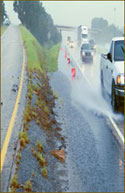For service in the Atlanta, Georgia area contact or call us:
What is Hydroplaning?
Hydroplaning happens when the tires of your vehicle are lifted up off the pavement surface by water. When your tires are riding on the water, you have no directional control of your vehicle.
You will be unable to steer or to brake. Your car will drift until the wheels regain traction or you crash into another vehicle or obstacle.

Hydroplaning is extremely dangerous. Many accidents occur because of the pooling of water on the roadway.
When you hydroplane, your vehicle will continue in the same direction it was going before you started to hydroplane. It is a very helpless feeling to be driving along at 60 mph and be unable to steer of brake your vehicle.
During rainy weather, be aware of the water on the roadway and adjust your speed accordingly. Drive carefully to avoid potential dangerous hydroplaning situations.
Tire Treads Depth
The tires of your vehicle are extremely important, since they connect the vehicle to the roadway. The better the traction between the tires and the road, the more control you have. Deep treaded tires improve the traction between the tires and the pavement surface. Tires are treaded to move water from under the tires.
Treads create a pathway for removing water between the tire and the pavement. When you travel rapidly through water, the tires cannot push water away quickly enough. Water builds up in front of the tires and they ride up on the water.
Vehicle Speed
Drive at a speed appropriate for wet weather conditions. High speeds increase the danger of hydroplaning. In rainy conditions, you should lower your speed. A vehicle will not hydroplane at slow speeds. You should also avoid pools of water and puddles on the roads. Pools of water on the roadway are often deeper than they look.
Newly licensed drivers should avoid driving during heavy rains. Experience requires time to become a skilled driver. Driving experience can only be gained over time. Young drivers have more traffic accidents than experienced drivers.
Inexperienced driver do not understand the danger of water on the roadway. Poor speed choices made in wet weather conditions can lead to harmful traffic accidents. Wet pavement adds one more factor in driving safely.
Never use cruise control when it is raining. The cruise control does not think “wet pavement” and turns itself off. You, the driver, must perform this function. So release your cruise control when it starts raining.
Properly Inflated Tires
Keep your tires properly inflated. Properly inflated tires reduce the risk of hydroplaning. An under inflated tire increases the risk of hydroplaning. Keep a close watch on the tread wear and replace tires when they become worn.
Check your car’s manual to determine the recommended pressure for your tires and check them often. Most tires lose pressure over time.
Under inflated tires increase tire wear. And tire wear causes your tires to wear out faster and decreases the time for tire replacement.
What To Do When Your Car Hydroplanes
If your vehicle starts to hydroplane, hold the steering wheel steady and do not slam on your brakes. You have little control over your car’s trajectory while it is hydroplaning. You need to ride it out.
Hard braking and steering can cause your car to change direction violently and potentially dangerously upon regaining tire/pavement traction. Let up on the gas pedal and gently steer your vehicle in the direction of the side of the road.
By steering to the roadway shoulder and your vehicle makes contact with the pavement, it will be directed away from on-coming traffic. Any braking should be done gently and with a soft touch to the brake.
Drive Safely to Avoid Hydroplaning
By using caution in wet conditions, you can prevent hydroplaning. Also, in increment weather watch out for other drivers who might be in trouble. A hydroplaning car could easily slam into you, causing serious damage to you and your vehicle.
Traction is the key to good control of your vehicle during movement, turning and stopping on wet surfaces. Good tire tread allows water to escape from under the tires, preventing loss of traction. Consider changing to tires designed for increased traction on wet surfaces. Make sure tires are properly inflated to the pressure shown in the owner’s manual or on the door frame.
Call Your Forensic Engineer
Further Reading About Hydroplaning
Hydroplaning caused by roadway defects
Qualifications of a good hydroplaning expert
Hydroplaning article written by Elvin Aycock for the American Institute of Hydrology.
Home Page - Atlanta Engineering Services
Ruts cause hydroplaning where the asphalt and the subgrade has failed.
Hydroplaning on roadways while transiting from superelevation to normal crown
Pavement drainage can be a problem in vertical curve sags and in transitions from superelevations to tangent sections.
More pavement drainage problems occur when the centerline crown is destroyed and superelevation transitions hold water.
G-ZNJ8QW23K9
